Nicolás Aparicio
A Standardized Benchmark for Multilabel Antimicrobial Peptide Classification
Nov 06, 2025Abstract:Antimicrobial peptides have emerged as promising molecules to combat antimicrobial resistance. However, fragmented datasets, inconsistent annotations, and the lack of standardized benchmarks hinder computational approaches and slow down the discovery of new candidates. To address these challenges, we present the Expanded Standardized Collection for Antimicrobial Peptide Evaluation (ESCAPE), an experimental framework integrating over 80.000 peptides from 27 validated repositories. Our dataset separates antimicrobial peptides from negative sequences and incorporates their functional annotations into a biologically coherent multilabel hierarchy, capturing activities across antibacterial, antifungal, antiviral, and antiparasitic classes. Building on ESCAPE, we propose a transformer-based model that leverages sequence and structural information to predict multiple functional activities of peptides. Our method achieves up to a 2.56% relative average improvement in mean Average Precision over the second-best method adapted for this task, establishing a new state-of-the-art multilabel peptide classification. ESCAPE provides a comprehensive and reproducible evaluation framework to advance AI-driven antimicrobial peptide research.
Comparative validation of surgical phase recognition, instrument keypoint estimation, and instrument instance segmentation in endoscopy: Results of the PhaKIR 2024 challenge
Jul 22, 2025Abstract:Reliable recognition and localization of surgical instruments in endoscopic video recordings are foundational for a wide range of applications in computer- and robot-assisted minimally invasive surgery (RAMIS), including surgical training, skill assessment, and autonomous assistance. However, robust performance under real-world conditions remains a significant challenge. Incorporating surgical context - such as the current procedural phase - has emerged as a promising strategy to improve robustness and interpretability. To address these challenges, we organized the Surgical Procedure Phase, Keypoint, and Instrument Recognition (PhaKIR) sub-challenge as part of the Endoscopic Vision (EndoVis) challenge at MICCAI 2024. We introduced a novel, multi-center dataset comprising thirteen full-length laparoscopic cholecystectomy videos collected from three distinct medical institutions, with unified annotations for three interrelated tasks: surgical phase recognition, instrument keypoint estimation, and instrument instance segmentation. Unlike existing datasets, ours enables joint investigation of instrument localization and procedural context within the same data while supporting the integration of temporal information across entire procedures. We report results and findings in accordance with the BIAS guidelines for biomedical image analysis challenges. The PhaKIR sub-challenge advances the field by providing a unique benchmark for developing temporally aware, context-driven methods in RAMIS and offers a high-quality resource to support future research in surgical scene understanding.
MuST: Multi-Scale Transformers for Surgical Phase Recognition
Jul 24, 2024

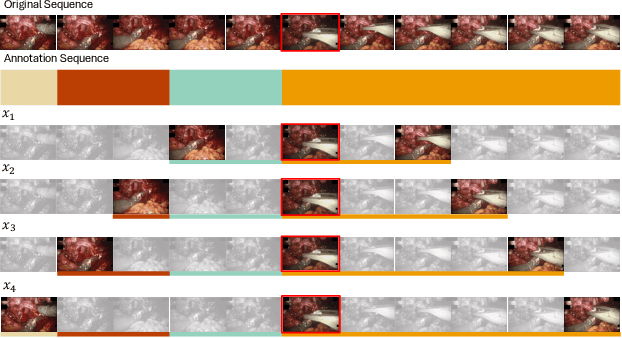
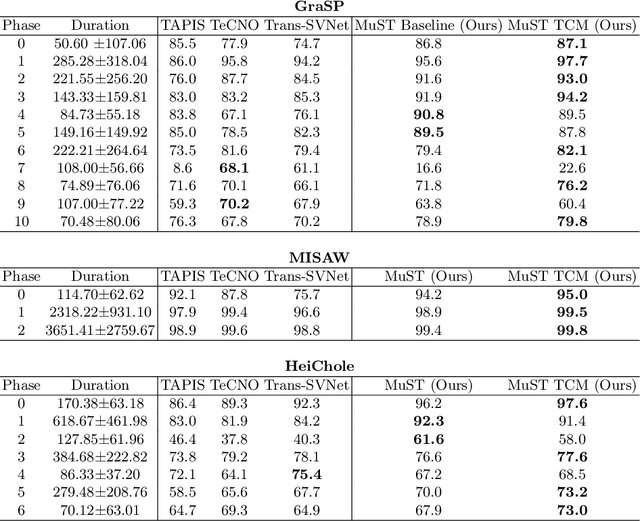
Abstract:Phase recognition in surgical videos is crucial for enhancing computer-aided surgical systems as it enables automated understanding of sequential procedural stages. Existing methods often rely on fixed temporal windows for video analysis to identify dynamic surgical phases. Thus, they struggle to simultaneously capture short-, mid-, and long-term information necessary to fully understand complex surgical procedures. To address these issues, we propose Multi-Scale Transformers for Surgical Phase Recognition (MuST), a novel Transformer-based approach that combines a Multi-Term Frame encoder with a Temporal Consistency Module to capture information across multiple temporal scales of a surgical video. Our Multi-Term Frame Encoder computes interdependencies across a hierarchy of temporal scales by sampling sequences at increasing strides around the frame of interest. Furthermore, we employ a long-term Transformer encoder over the frame embeddings to further enhance long-term reasoning. MuST achieves higher performance than previous state-of-the-art methods on three different public benchmarks.
Pixel-Wise Recognition for Holistic Surgical Scene Understanding
Jan 26, 2024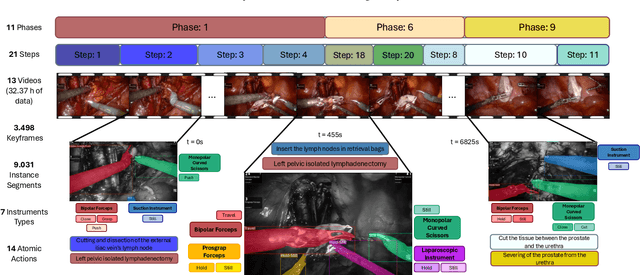
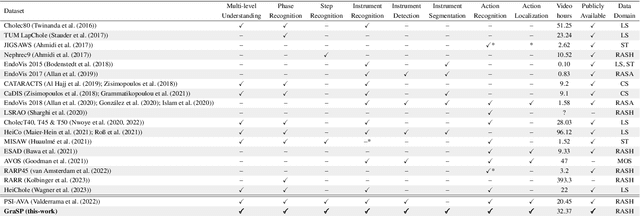
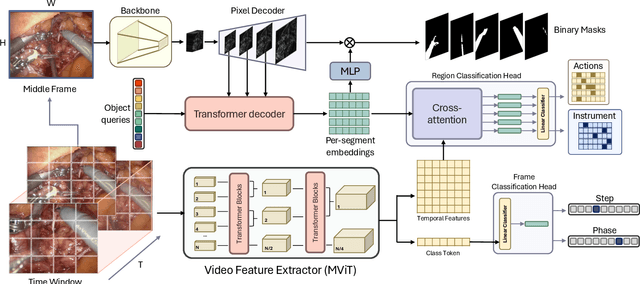
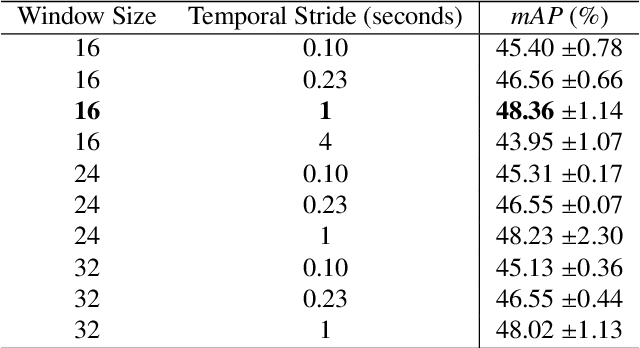
Abstract:This paper presents the Holistic and Multi-Granular Surgical Scene Understanding of Prostatectomies (GraSP) dataset, a curated benchmark that models surgical scene understanding as a hierarchy of complementary tasks with varying levels of granularity. Our approach enables a multi-level comprehension of surgical activities, encompassing long-term tasks such as surgical phases and steps recognition and short-term tasks including surgical instrument segmentation and atomic visual actions detection. To exploit our proposed benchmark, we introduce the Transformers for Actions, Phases, Steps, and Instrument Segmentation (TAPIS) model, a general architecture that combines a global video feature extractor with localized region proposals from an instrument segmentation model to tackle the multi-granularity of our benchmark. Through extensive experimentation, we demonstrate the impact of including segmentation annotations in short-term recognition tasks, highlight the varying granularity requirements of each task, and establish TAPIS's superiority over previously proposed baselines and conventional CNN-based models. Additionally, we validate the robustness of our method across multiple public benchmarks, confirming the reliability and applicability of our dataset. This work represents a significant step forward in Endoscopic Vision, offering a novel and comprehensive framework for future research towards a holistic understanding of surgical procedures.
 Add to Chrome
Add to Chrome Add to Firefox
Add to Firefox Add to Edge
Add to Edge